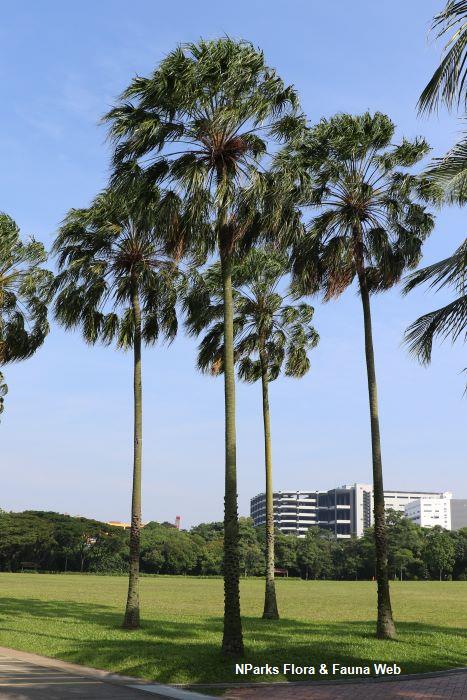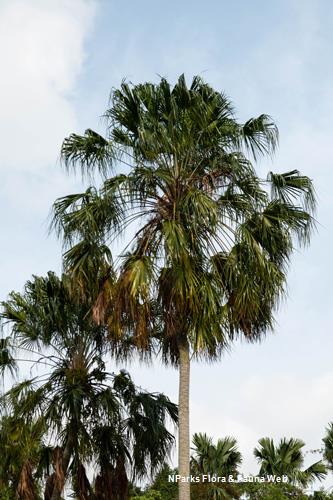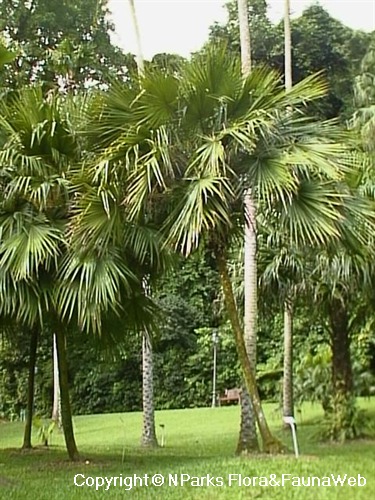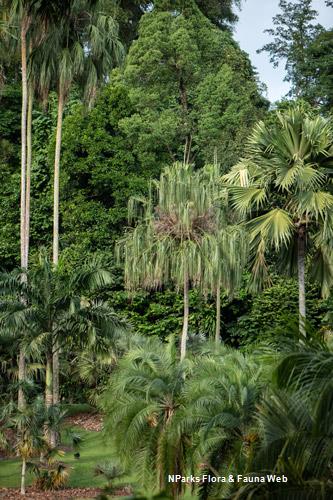
Back
Livistona benthamii F.M.Bailey
| Family Name: | Arecaceae (Palmae) |
| Synonyms: | Livistona holtzei Becc., Livistona melanocarpa Burret |
| Common Name: | Bentham's Fan Palm, Fan Palm, Cabbage Palm |
Livistona benthamii, also known as Bentham's Fan Palm, is a solitary palm which can reach up to 18 m tall. Petiole stubs remain on the stem even after the leaves fall off. It has long petiole which are armed with curved black spines along the margin. Coarse fibers are prominent and present at the base of the petiole.
Name
Classifications and Characteristics
| Plant Division | Angiosperms (Flowering Seed Plants) (Monocotyledon) |
|---|---|
| Plant Growth Form | Palm (Solitary Habit) |
| Lifespan (in Singapore) | Perennial |
| Mode of Nutrition | Autotrophic |
| Maximum Height | 18 m |
Biogeography
| Native Distribution | New Guinea to Australia. |
|---|---|
| Native Habitat | Terrestrial (Monsoon Forest, Freshwater Swamp Forest) |
| Preferred Climate Zone | Tropical |
| Local Conservation Status | Non-native |
Description and Ethnobotany
| Growth Form | It is a single-stemmed palm that can reach up to 18 m tall. The frond bases remain attached to the stem even after the leaves have fallen off. These stubs persist on the trunk for most of its length unless decayed by age or fire. |
|---|---|
| Foliage | The fronds are fan-shaped (costapalmate), about 0.9 – 1.6 m long, and deeply divided for 60 – 75% of the length. The fronds are regularly segmented and can have 50 – 80 segments each. The petioles (leaf stalks) can reach up to 2 m long and are armed with curved black spines along the margin. Coarse fibres are prominent and present at the base of the petiole. |
| Flowers | The inflorescences are borne between the leaves (interfoliar) and can reach 1.2 – 2 m long. Each inflorescence comprises many cream to pale yellow flowers. The species is functionally dioecious. |
| Fruit | The fruit is round to obovoid (about 0.9 – 1.1 cm diameter), smooth and fleshy. It turns purple-black when mature. Each fruit contains one seed. |
| Habitat | It can be found in swamp forests, on alluvial flats, on the leeward side of mangroves and in moist to wet areas in monsoonal thickets and gallery forests at low elevations from 0 - 100 m above sea level. |
| Associated Flora | Flowers are pollinated by insects. |
| Cultivation | It can be propagated by seed. |
| Etymology | The genus Livistona is named in honour of Sir Patrick Murray (1632 – 1671), 2nd Lord of Elibank and 17th century Baron of Livingstone, who donated his private plant collection after his death and helped found the Edinburgh Botanic Garden. The specific epithet benthamii is named in honour of George Bentham, the British botanist and co-author of the Flora Australiensis. |
Landscaping Features
| Desirable Plant Features | Ornamental Form |
|---|---|
| Landscape Uses | Suitable for Roadsides, General |
Fauna, Pollination and Dispersal
| Pollination Method(s) | Biotic (Fauna) |
|---|
Plant Care and Propagation
| Light Preference | Full Sun |
|---|---|
| Water Preference | Moderate Water |
| Plant Growth Rate | Moderate |
| Propagation Method | Seed |
Foliar
| Foliage Retention | Evergreen |
|---|---|
| Mature Foliage Colour(s) | Green |
| Foliar Type | Compound (Palmate) |
| Foliar Arrangement Along Stem | Spiral |
| Foliar Attachment to Stem | Petiolate |
| Foliar Shape(s) | Palm Fronds (Fan / Costapalmate) |
| Leaf Area Index (LAI) for Green Plot Ratio | 2.5 (Palm - Solitary) |
Non - Foliar and Storage
| Trunk Type (Palm) | Solitary Habit, Aboveground |
|---|---|
| Root Type | Underground (Fibrous Root) |
Floral (Angiosperm)
| Flower & Plant Sexuality | Unisexual Flowers , Dioecious |
| Flower Colour(s) | Cream / Off-White |
|---|
| Flower Grouping | Cluster / Inflorescence |
| Flower Location | Axillary |
| Flowering Habit | Polycarpic |
Fruit, Seed and Spore
| Mature Fruit Colour(s) | Black, Purple |
|---|---|
| Mature Fruit Texture(s) | Smooth |
| Fruit Type | Fleshy Fruit , Drupe |
References
| References | Dowe, J.L. (2009). A taxonomic account of Livistona R.Br. (Arecaceae). Gardens' Bulletin Singapore 60: 185-344. |
|---|
Image Repository
Others
| Master ID | 32915 |
|---|---|
| Species ID | 7329 |
| Flora Disclaimer | The information in this website has been compiled from reliable sources, such as reference works on medicinal plants. It is not a substitute for medical advice or treatment and NParks does not purport to provide any medical advice. Readers should always consult his/her physician before using or consuming a plant for medicinal purposes. |


_lowres.jpg)
_lowres.jpg)

_lowres.jpg)
_lowres.jpg)

